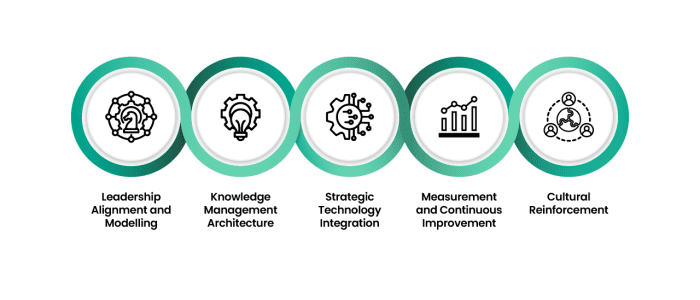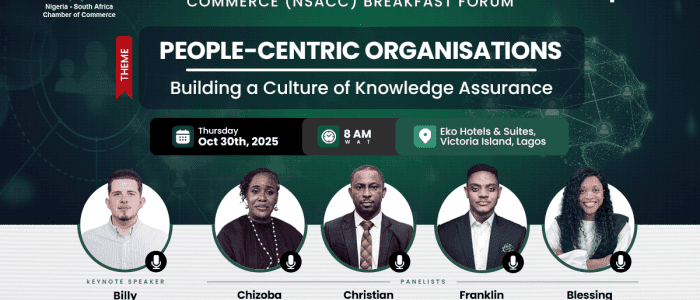A Strategic Imperative for C-Suite Leadership
Every day, there is a quiet crisis in the halls of corporate Nigeria and in boardrooms throughout the world, the systematic erosion of institutional knowledge. Phillips Consulting (TMR 2023), Gunter, A. (2024), and LinkedIn (2025) show that when a long-time employee or executive leaves, approximately 42% of their knowledge about the firm goes with them. This makes it hard for organisations to recreate skills that took years to acquire. This loss of information costs businesses around the world about $31.5 billion per year, yet most executives don’t realise how big a problem it is until it affects their bottom line.
The answer isn’t improved exit interviews or better documentation procedures; it’s to rethink how companies see knowledge as a strategic asset completely. Welcome to the era of knowledge assurance, a deliberate approach to ensuring that essential knowledge and skills are not only acquired but also retained, shared, and continually improved within organisations.
The Knowledge Paradox: More Training, Less Learning
Harvard Business School research reveals a worrying paradox: even as companies are spending more than ever on training and development for their employees, they still struggle to translate what they learn into lasting changes in behaviour and the company’s ability to execute effectively. Studies demonstrate that after only two weeks, employees only remember 30% of what they learnt in standard training programmes. Yes, you read that correctly, 70% of your training budget essentially vanished into thin air.
Individual forgetfulness is just the tip of the iceberg, though. The International Data Corporation (IDC) did a study that showed that in any 1,000-person company, employees waste nearly an entire workday each week, that’s 20% of their time, searching for information they know exists somewhere within their own organisation. This translates to a loss of $300,000 per week due to duplicated work, reinvented solutions, and lost productivity.
So why does this keep happening? It has been described as a “knowledge acquisition trap.” Most organisations are great at creating and capturing information, but they struggle with interpreting, storing, and utilising that information in a helpful way. Authentic learning companies must be proficient at generating, acquiring, interpreting, transferring, and preserving knowledge, while purposefully modifying behaviour to reflect new insights.
Knowledge Assurance: Beyond the Checkboxes
Knowledge assurance extends beyond traditional training metrics and compliance checklists. It shows that the whole organisation is committed to three related goals:
- Systematic Knowledge Capture: Turning tacit knowledge, employees’ insights, intuitions, and experiential wisdom into clear, defined assets that everyone in the business can use. This includes conducting controlled interviews with subject matter experts, creating detailed records, and digitising proprietary processes and institutional memory.
- Retention Architecture: One-shot training sessions are dead. Evidence-based retention strategies include spaced repetition (revisiting material at strategic intervals), active retrieval practice (forcing individuals to recall information rather than passively reviewing it), and contextual application (utilising knowledge in real-world workplace situations). This approach can boost retention by 50% compared to cramming everything into intensive workshops.
- Cultural Embedding. This is where most organisations trip up You need psychological safety—people must feel comfortable saying “I don’t know” or “I failed” without career consequences. Recognition systems should reward knowledge sharing, and organisational norms should treat continuous learning as a core business, not some feel-good HR side project. Get this right, and you’ll see 30-50% better retention rates plus 46% higher ROI on training investments.
People-Centric Transformation: Why Technology Fails Without Hearts and Minds
Want a statistic that’ll haunt your next digital transformation meeting? More than 70% of these initiatives fail to deliver on their promises. The reason? Organisations consistently make the same mistake; they obsess over technology deployment while neglecting the humans who must use it.
Gallup’s vast study on workplaces couldn’t be clearer: “organisations with strong, highly engaged cultures are much more able to handle tough times. Their meta-analyses indicate substantial evidence of causal relationships between engagement factors and performance, with the best businesses attaining 70% or more engaged employees, three times the global average”.
Picture this scenario. Two companies implement identical learning management systems. Company A focuses purely on technical deployment, migrating content, configuring user permissions, and sending out launch announcements, only to wonder why nobody uses it. Company B invests just as heavily in change management, creates safe spaces for experimentation, provides extensive coaching, and connects learning pathways to what employees care about achieving.
Harvard Medical School’s online learning research reveals the dramatic difference in outcomes. Well-designed digital platforms paired with people-centric implementation generate significant knowledge and confidence gains. Deploy those same platforms without considering human factors? You get minimal impact despite identical technical capabilities.
Knowledge assurance is fundamentally about cultural transformation, not technology implementation. Success requires leaders who establish psychological safety, communicate an inspiring vision, and genuinely engage employees, rather than leaders who mandate adoption and hope for the best.
Digital Learning Platforms: The Infrastructure That Enables Success
Modern digital learning platforms are very important when they are used in people-centred frameworks, but technology alone can’t make sure that people remember what they learn. These platforms help with knowledge assurance goals in several ways:
- Accessibility and Democratisation: Digital platforms make it easier for people to get knowledge by removing time and space restrictions. The Central Bank of Nigeria’s eight-year use of Skillsoft’s Percipio platform is an example of this principle. Through this platform, thousands of employees in different regions and subsidiaries access standardised training and proprietary institutional knowledge, supporting massive internal transformation
- Proprietary Content Codification lets businesses turn their institutional knowledge into digital learning assets. The Nigerian National Petroleum Company Limited (NNPC) collaborated with Phillips Consulting to transform the complex, hundreds-of-pages Petroleum Industry Act (PIA) into six user-friendly digital modules within a four-month timeframe. This changed the way employees, subsidiaries, and affiliated agencies can access the PIA knowledge. This is an example of knowledge assurance in action: important regulatory information is documented, made accessible to everyone, and readily available to employees.
- Data-Driven Insights: Digital platforms give us a lot of information about how engaged employees are in learning, how well they remember what they’ve learned, and how they use what they’ve learned in real life. Companies can therefore monitor more than just course completion rates. They can also measure real skill growth, knowledge gaps, and business impact. This transforms learning from a cost centre into a demonstrable value driver.
- Scalable Knowledge Transfer: Organisations can create comprehensive knowledge ecosystems by combining curated external content with internally developed expertise. This way, new employees can access institutional wisdom from day one. For example, Percipio offers 200GB of free space for the provision of proprietary content.
C-Suite Awakening: Learning as Strategic Priority
In my August 2025 article on “The Missing Seat: Why Nigeria’s Learning Leaders Must Join the Boardroom”, I make a strong case for learning & development to become a strategic priority for the C-suite instead of just an HR function. Forward-thinking companies are hiring Chief Learning Officers who sit on the executive board. Organisations making such strategic placements show that learning is the “internal engine of organisational change and optimal performance.”
This move recognises three critical truths:
- Competitive Advantage Through Capability: In knowledge economies, a company’s capabilities are just as important as its products or market position when it comes to long-term competitive advantage. Companies with a strong culture of learning exhibit greater innovation, improved performance, and a more competitive position. Millennials, who are now the largest group of workers, say that the chance to learn and improve is the most crucial factor in their job choices. This gives firms that focus on learning a significant edge when it comes to hiring.
- ROI Justification: Digital learning platforms provide quantifiable benefits. Research shows that companies that utilise complete digital learning programs experience a 24% increase in productivity, a 42% rise in employee engagement, and cost savings of up to 70% compared to traditional classroom training. IBM’s study reveals that for every $1 invested in digital learning projects, the average return is $30.
- Agility and Adaptability: As technology changes quickly, the time it takes for technical abilities to become obsolete keeps getting shorter. Companies that allocate more than 20% of their transformation budgets to training and development are twice as likely to achieve effective outcomes. Knowledge assurance provides the foundation for organisational agility, enabling rapid development of capability when markets shift unexpectedly.
From Codification to Culture: Putting Knowledge Assurance into Action
To make sure that knowledge is sustainable, C-suite leaders need to orchestrate five interconnected initiatives:
- Leadership Alignment and Modelling: Executives need to show that they are committed to learning all the time, share their own learning experiences, and make knowledge sharing a part of how they evaluate and reward employees. When leaders demonstrate that it’s okay to be vulnerable while learning, by admitting what they don’t know and recognising mistakes as opportunities to learn, they create a psychological safety that is necessary for cultures of knowledge sharing.
- Knowledge Management Architecture: Organisations need to come up with systematic ways to codify knowledge that balance what organisational theorists call “codification strategies” (document-centred, system-oriented ways to manage explicit knowledge) with “personalisation strategies” (human-oriented ways that focus on networking and tacit knowledge transfer). Both are necessary; neither is sufficient on its own.
- Strategic Technology Integration: When choosing and setting up digital learning platforms, you should think about knowledge assurance goals instead of just the features they offer. Some important considerations include the amount of private content that can be stored, data analysis capabilities, integration with existing systems, and support for various learning types, such as microlearning, social learning, and AI-powered personalisation.
- Measurement and Continuous Improvement: Organisations must transcend conventional training measures (completion rates, satisfaction scores) to assess genuine knowledge retention, behavioural modification, and business impact. This involves identifying the right Key Performance Indicators (KPIs) that align with the organisation’s goals, such as enhancing employee performance, improving knowledge retention rates, achieving cost savings, or closing capacity gaps.
- Cultural Reinforcement: Organisations need to make sharing knowledge a regular part of their routines, give rewards for it, and make it a part of their culture. This includes initiatives such as “lunch and learn” meetings, cross-functional collaborative projects, mentoring programs that facilitate the sharing of tacit knowledge, and public recognition of consistent knowledge contributors.
Digital Transformation as a National Imperative in Nigeria
The 3 Million Technical Talent (3MTT) programme in Nigeria, the world’s largest recognised talent accelerator, demonstrates the importance of building digital skills. Nigeria has a unique demographic advantage that enables the country to become a global leader in digital services. Approximately 70% of the population is under the age of 35. To reach this potential, though, we need to go beyond general education to employment-ready skills directly aligned with market demands.
The Central Bank of Nigeria, NNPC Limited, Interswitch Nigeria, Bank of Industry, National College of Aviation, Zaria, TSL Logistics, and MTN are just a few examples of organisations that show how the strategic use of digital learning platforms can help organisations change and improve the country’s digital skills. These implementations teach other businesses three crucial lessons:
- Speed and Agility Matter: NNPC’s ability to turn a two-year content digitisation challenge into a four-month implementation shows how dedicated collaborations between organisations and expert implementation partners can speed up the process of knowledge assurance.
- Long-Term Commitment Yields Compounding Returns: CBN’s eight-year Skillsoft Percipio deployment shows how a long-term commitment to digital learning can lead to compounding benefits, such as supporting multiple strategic goals through knowledge resources that are always available and changing.
- Integration with Strategic Objectives: The best implementations, like Interswitch’s approach, firmly link learning programmes with business goals instead of considering them as separate HR tasks.
The Path Ahead: Your Organisation’s Journey to Knowledge Assurance
As leaders in the C-suite, you face a tough choice to either continue accepting knowledge loss as an unavoidable part of doing business or rethink how your organisation treats information as a strategic asset that deserves systematic assurance.
The proof is clear. Companies that adopt people-centred knowledge assurance cultures, which include strategic digital learning platforms, systematic knowledge codification, evidence-based retention practices, and a genuine commitment to culture, see measurable benefits in retention, productivity, innovation, and competitive positioning.
It’s not a question of whether to invest in knowledge assurance; it’s a matter of how quickly you can initiate the change. Every day you wait means that valuable institutional knowledge is leaving your doors, chances to improve your skills are lost, and your competitors who are more focused on learning are gaining an edge over you. The “japa movement” that caused the recent brain drain left lasting scars.
Your journey starts with one promise to view every employee not merely as a deployable resource, but as a knowledge repository to nurture, a learner to empower, and a contributor to your organisation’s collective intelligence. This is what people-centred organisations are built on, the foundation where knowledge assurance cultures flourish.
The Nigerian-South African Chamber of Commerce Breakfast Conversation
October 30, 2025, join C-suite executives and Chief Learning Officers for an immersive exploration of people-centric knowledge assurance strategies. The session features keynote insights from Skillsoft, panel discussions with leaders from the Central Bank of Nigeria, Interswitch Nigeria, MTN, and Phillips Consulting, as well as client success stories, such as NNPC’s PIA digitisation project, demonstrating real-world implementations. You’ll walk away with actionable frameworks for elevating knowledge assurance to a strategic priority within your organisation.
Written by:
Paul Ayim
Digital Learning



